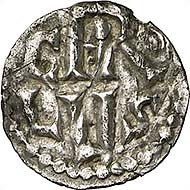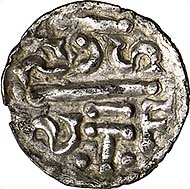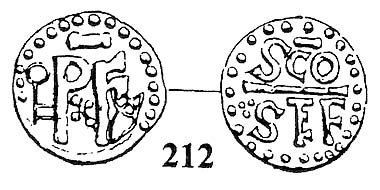by Sebastian Steinbach
In the March 2010 auction sale of the auction and coin trading company Fritz Rudolf Künker in Osnabruck an extraordinary coin from the reign of Charles the Great will be offered for sale.
Fig. 1: Charles the Great (768-814). Denarius, Bourges (Saint-Étienne). Double-spaced CARo / LVS//Double-spaced SCS / S-TF, separated by a beam. Morrison/Grunthal – (specimen from auction sale Fritz Rudolf Künker 165, nr. 65).
The specimen (fig. 1) states on its obverse in two lines the Emperors’ name CARo / LVS and on the reverse the equally double-spaced legend SCS / S-TF separated by a horizontal beam. The diameter of 18.25 mm and the weight of 1.11 g identify the piece as a denarius.
The coin was produced during the second minting period of Charles the Great as is testified by the image with its double-spaced royal name. The denarius, therefore, most possibly dates to the time between the death of Charles’ brother Carloman (768-771) and before the introduction of the denarii novi mentioned in the resolutions of the Council of Frankfurt in 793/794.
The attribution of the reverse is more difficult. Such a type of Charles the Great is recorded neither in K. Morrison / H. Grunthal nor in G. Depeyrot, neither in M. Prou nor in E. Gariel. There is, however, a denarius extant, known in tree copies, from the reign of his father, Pippin the Short (752-768), with a similar legend on its reverse.
Fig. 2: Pippin the Short (752-768). Denarius, (Saint-Étienne). PxF between key and cross// Double-spaced SCO / STEF, separated by a beam. Morrison/Grunthal 77. Illustration in G. Depeyrot (p. 185, nr. 212).
That coin type (Morrison/Grunthal 77, Depeyrot 212, Gariel III, 61) shows on its obverse the Emperor’s name in the form PxF (= monogram Rex Pippinus) between a key and a cross-like symbol. On the reverse one can read the double-spaced legend SCO / STEF separated by a horizontal beam (fig. 2). Whereas K. Morrision / H. Grunthal waived an attribution of the denarius and simply listed the type under the series of “Epigraphical Reverses“ from an unknown mint, G. Depeyrot reads the legend SCO STEF as SanCtOs STEFanvs and locates the coin in Bourges whose Gothic cathedral has a Stephanus patrocinium (Saint-Étienne).
If one understands the beam above the T in the reverse’s legend of the unedited CAROLVS denarius of the Künker sale as a ligature of E and T, then its reverse legend can be dissolved as SanCtvS STEFanvs. Hence, the coin was likewise minted in Bourges / Saint-Étienne.
G. Depeyrot lists another denarius (no. 213) from the second minting period of Charles the Great, allegedly a single piece from the Dijon hoard. According to the description (unfortunately, there is no illustration) that coin likewise states on its obverse the double-spaced name CARo / LVS and on its reverse a double-spaced SCI / SEPHF – hence, also Saint-Étienne.
To briefly summarize: the denarius offered for sale displaying the legend SCS / ST-F undoubtedly belongs to the context of the Bourges / Saint-Étienne mint. The exact relationship of this piece with the much more common coins stating the city name BITVRICES or the unique specimen of a denarius from Bourges / Saint-Sulpice with a double-spaced SCI / SVLP (minted under Louis the Pious, 814-840, Depeyrot 215), however, remains unclear. Perhaps the latter was a kind of “commemorative coinage” since Sulpicius II had become Bishop of Bourges in 624 and the 200th anniversary, therefore, would have been celebrated during the reign of Louis the Pious – but that is just a wild guess. This coin once again vouches for the fact that the coin minting of the Early Medieval Times will continue to pose the numismatists many a riddle.
Literature:
- Depeyrot, G.: Le numéraire carolingien. Corpus des monnaies, Wetteren 2008.
- Gariel, E.: Les monnaies Royales de France sous la Race Carolingiennes, Paris / Strasbourg 1884 / 1885.
- Grierson, P. / Blackburn, M.: Medieval European Coinage. I. The Early Middle Ages (5th-10th centuries, Cambridge 1986.
- Kluge, B.: Numismatik des Mittelalters. Handbuch und Thesaurus Nummorum Medii Aevi, Berlin / Wien 2007.
- Morrison, K. F. / Grunthal, H.: Carolingian Coinage (Numismatic Notes and Monographs, No. 158), New York 1967.
- Prou, M. M.: Catalogue des monnaies françaises de la Bibliothèque Nationale. Les Monnaies Carolingiennes, Paris 1896.
More carolingian Coins can be found at the sale 165 of Fritz Rudolf Künker (March 2010) at:
http://www.kuenker.de/onlineAuctionListe.asp?lid=4&nid=145&s2id=101388&lager=00058








